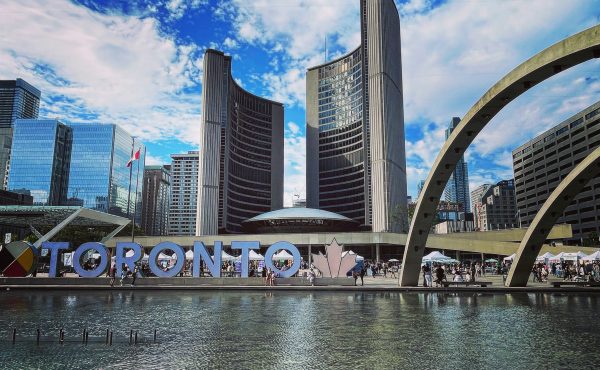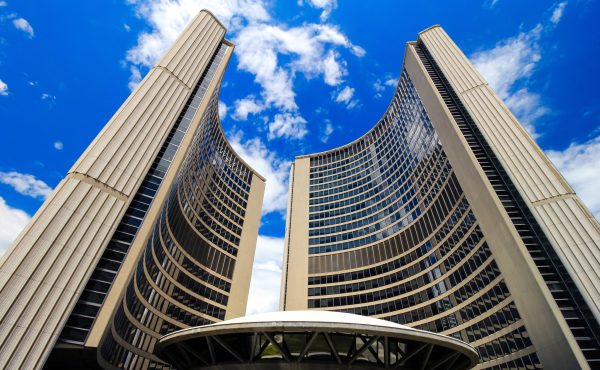

I didn’t agree with every position Jack Layton espoused, but I have never forgotten one of his signature political lessons – an approach he once described when I was writing a profile during his run for the NDP leadership. Having struggled in the 1980s to gain traction at Toronto city council with a strident brand of lefty rhetoric, Layton embrace “propositional” politics. He came to realize it was better, and more positive, to advocate for something rather than just to oppose things.
We’ve seen a lot of opposition to Mayor Rob Ford’s administration in this past year, and a great deal of it is spot on. But on the anniversary of Ford’s victory — and also on the eve of the opening of the “Fourth Wall” project at The Urban Space Gallery — I’d like to borrow a page from Layton’s book and propose a sort-of new idea to advance the debate about the state of the city.
Sort of, because I’m shamelessly cribbing a very interesting idea that’s been buzzing around Calgary in the past few weeks, advanced by George Brookman, a former head of the Calgary Stampede, and Brian Felesky, a lawyer who is the vice-chair of Credit Bank Suisse Canada.
Picking up on an April proposal from the Canada West Foundation, Brookman and Felesky — a.k.a. Transformation Calgary — have pitched the following plan: the city should ask Alberta and Ottawa for permission to levy an additional cent on the GST collected within the city borders. The funds — an estimated $300 million annually — would go towards building and operating new recreation and arts facilities. The hitch: voters would have to approve the plan before the levy takes effect. (They could also rescind it if things aren’t going as planned.)
At first glance, their idea evokes David Miller’s “One Cent Now” campaign. But Transformation Calgary’s scheme is different in several crucial ways: Rather than disappear into general revenue, the funds would be earmarked, time-limited and locally generated. Most importantly, they are subject to political scrutiny. It’s not just about begging for handouts – deserved though they may be — from another order of government; local politicians would have to have skin in this game.
So how to transpose this to Hogtown?
First step: develop a short list of “transformational” needs. It’s safe to say that many Torontonians would put transit near the top, but the process of figuring out what else might qualify is a broad-based debate well worth having.
Second, establish the scale. If we’re going to seek a penny tax to build transit to help alleviate congestion, the discussion needs to take place across the metropolitan region, not just within the City of Toronto.
Third, look at potential revenues. A penny tax just on retail sales in the Toronto region would generate about $620 million a year. (For the sake of context, Metrolinx’s Big Move plan will cost about $2 billion a year for the next 25 years.)
Fourth, consider the instrument. Is the HST the right vehicle, so to speak, or should we be thinking of a GTA-wide parking levy or some other tax? After all, Alberta has no HST, so value-added taxes in the Calgary area are lower than here.
The business of formalizing this discussion is not trivial. We all know that Mayor Ford doesn’t believe that the city needs more revenue, and it’s also true that the municipal councils within the urbanized portion of the GTA have never been capable of collective decision-making. Moreover, Dalton McGuinty’s Liberals need to be engaged, as the execution and administration of such a plan – as Bookman and Felesky well know – depends on a series of provincial approvals.
Does Metrolinx lead the debate? Possibly. But this kind of political advocacy needs to begin outside the walls of government so it doesn’t seem self-serving. So perhaps the place to begin is with engaged civil society groups and in settings such as the Toronto Mobility Forum on Nov. 9, a joint venture of U of T’s Cities Centre, CivicAction, the Canadian Urban Transit Association and the Pembina Institute.
Certainly, David Miller has rekindled public interest in resurrecting Transit City, and there will be much discussion about that particular goal. But the debate about transit and congestion is a regional issue, and should be treated as such.
From where I sit, the Transform Calgary guys are offering up a game-changing strategy – propositional politics at its best. We should study it closely.




14 comments
Great idea. I’m concerned that there’s a lot of “if’s” to get it off the ground. As I see it, the first step is to somehow get the GTA and surrounding municipalities to start thinking like a region.
My problem with the old “1 cent” campaign, and probably its main attraction to municipal politicians, was that the money was raised by one level of govt (the feds) and spent by another (the city). What a delight: free money.
The best taxes are those raised visibly, where the taxpayer can see who is dinging him for how much, and relate it to the value — or lack of value — being received.This promotes citizen oversight and control over spending. The new proposal for an additional % on the HST, levied on a metropolitan area, might fly. But it is much more than one cent this time, a single percent increase on the HST is an 8% increase in the tax. This will make it a much harder sell. IMO, a main problem for cities is that they have a huge disconnect be what they spend and what they charge for it. How many roads would we have if we had full life cycle costing? How many more low density areas would we have if we knew their long term cost/revenue ratio instead of the short-term Ponzi scheme we have now. How many fewer dilapidated bridges would we have if users paid for their maintenance, repair, and paid down their mortgage? Municipalities are in trouble because they give away too much stuff. It’s easy being a fairy godparent; much less fun balancing the books.
This is hardly radical stuff in the US, where laws in most states allow the local municipality to control the final amount of sales tax. Bigger cities tend to charge more tax to cover their larger service load. For example, take this blurb from Wikipedia:
——-
New York has a 4% state sales tax. All counties and some cities add local taxes ranging from 3% to 4.75%. The combined sales tax in Utica, for example, is 8.75%. In New York City, total sales tax is 8.875%, which includes 0.375% charged for the service of the Metropolitan Transportation Authority.
——
And there you have it. I wish Canadians would take off the blinders, drop the old stereotypes about being superior, and look the US for solutions at a municipal level now and then. It has been twenty five years since the Americans stopped coming to Toronto to see how to make a city work, and they’ve been busy trying all sorts of stuff, with some real successes, since. Learn from it.
John, why are you not on council? Hell, why aren’t you running for mayor?
“The best taxes are those raised visibly, where the taxpayer can see who is dinging him for how much, and relate it to the value — or lack of value — being received.”
Is that slightly increased transparency worth the huge additional costs of paying for the extra bureaucracy to run something like that exclusively for the city?
Good points. But somebody has to move the motions. It seems to me lately that the council’s left are basically sitting on their hands enjoying the sight of Ford stumbling. Shooting down bad plans is all good, but why not also try to do something more constructive? Start to move some motions that will better the city. Yes, I am talking about you Adam Vaughan. I told you personally that I’d vote for you if you jumped into the mayoral race, I still stand by that, but I’d love to see you making a difference before you get there.
John,
I agree with you – this is a perfectly reasonable proposal. I also agree with many of the previous posters – we should be looking outside our borders, particularly to the U.S., for models of funding and running our municipal governments and services.
But why are you writing this? Particularly as your suggestion runs entirely contrary to the mantra of the ideologues who currently hold sway at City Hall. Remember? “…Toronto doesn’t have a revenue problem; it has a spending problem…” (Not that either of the Ford brothers would ever condescend to using semi-colons.) So why did you write an article on municipal governance and transportation financing entirely without reference to the current régime? It’s like your article exists in a bubble, floating autonomously in space, unencumbered by the gravity of local politics and Ayn Rand-inspired ideologues. This article is the fiscal equivalent of the train nerds who draw extensive new subway lines on maps without ever pausing to think what is right to build and what might get built in the current political context. Drawing the maps becomes an end in itself.
It’s a waste of your energy and considerable knowledge of City Hall. Unless you are contemplating running for office in three years time when the electorate will rebuke the current régime and discard their Pol Pot-style year-zero agenda. At which point we will likely have to rebuild many aspects of our public policy from the ground up, and we will need suggestions like yours.
However in the meantime Rob Ford’s mayoralty is unravelling. He is comically sloven; he can’t keep his story straight; (as you have pointed out in your G&M series) he is reluctant to tell us who funded his campaign. Now it turns out he is a grown man who is scared of clowns. I think it should be clear to anyone that his insecurities are to some extent legitimate – he is being ground down by the realization of how far out of his depth he has found himself.
Do you think maybe some of those issues merit some discussion? Even in a journal dedicated to “urban space”?
Looking forward to your next article.
@MER1978: What “huge additional cost”? Businesses already have a process for calculating their HST bill. All it would need is one extra question: “is your company located in Toronto?” If “yes”, you pay one rate, if “no”, a different rate.
If you do business in Toronto and elsewhere, it would be worse than doing business in two different provinces.
Just to be clear (because I had to read it carefully a couple of times): we’re talking about adding one cent (a penny), not one percent to the existing tax already collected on every retail sale.
That seems like a no brainer to me.
Here is a 2 billion dollar idea. Instead of trying to avoid the visibilty of spending via very visible property tax, grow up be honest with citizens. The gabage fees, increased water rates, ltt, vrt, one cent campaign, were all ways to avoid this visibility.
If the city was courageous enough it would explain to residents that it can no longer offer basic services far below the cost to provide them. If the city could recoup, on average, the cost of traditional municipal services from households it would have nearly 2 Billion dollars more in revenue. That would be enough to close the structual defecit and leave enough for city building.
“If the city was courageous enough it would explain to residents that it can no longer offer basic services far below the cost to provide them.”
Glen, who is “the city”? You mean the person who speaks on behalf of the City government, yes? Are you loath to imply our Mayor is not courageous?
@Eric Darwin:
“My problem with the old “1 cent” campaign, and probably its main attraction to municipal politicians, was that the money was raised by one level of govt (the feds) and spent by another (the city).”
How interesting. Here’s an alternative formulation – a share of the GST returns a share of the economic taxation reaped by higher government through little effort, said economic activity which was promoted at its own cost by a lower level.
The City pumps hundreds of thousands of dollars into festivals and other activities in Toronto every year, and the best it can hope for in terms of economic return is that the vendors at these festival can afford to move to a nicer house – assuming that house is in the 416 of course. Meanwhile the province and the feds reap HST, income tax/EI (from increased hiring/overtime), corporate taxes etc. from the increase activity in a direct fashion.
No, Rob Ford is not courageous. Even less courageous was David Miller. He bathed in the glory of spending while using hundreds of millions of reserve funds to pay for it. Spending under Miller increased more than all sources of revenue.
I am waiting for a leader who won’t cut taxes for the undertaxed or spend and leave the tab for future administrations.
Please don’t let this conversation be high jacked by one person’s hate-on for the tax structure of the city. He is just a second rate furrier, so there is no real need to engage with his loathing of a past mayor.
What is most depressing is that this idea can be easily worked out and implemented with the citizens’ needs first and foremost. But sadly, our current crop of political leaders do not have the spine to stick up for us.